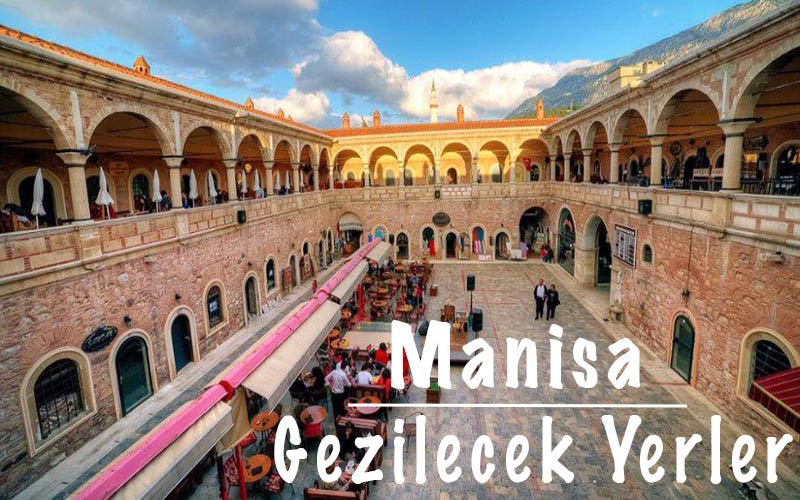Considered as the second largest city within the borders of the Aegean Region, known as a settlement since ancient times, it has served as the capital of many civilizations in its historical continuity, and it is a Princes’ homeland where many princes grew up in the Ottoman Period. In >Manisa, it offers many alternatives to visit with its areas that offer natural beauties provided by its geographical features and historical ruins from the ancient and Roman periods, as well as artifacts from the Ottoman period.. So, let’s share our “Places to Visit in Manisa” list that we recommend you to read before making your trip…
Places to Visit in Manisa
Aigai Ancient City
The Ancient City of Aigai, also known as Nemrut Kale, which is one of the 12 Aeolian cities in Western Anatolia mentioned by Herodotus, is located at a distance of about 49 km from Manisa. Date M. HE. 8. dating back to the century and. S. Although it is known that the Ancient City, which was largely damaged and repaired during the earthquake in 17, was an important commercial center during the Hellenistic period, no serious excavation work was carried out in the ancient city.. Within the city walls, which were built according to the characteristics of the land on which it was built, there are ruins such as the three-storey agora and the walls carrying this structure, the parliament building, the stadium with terrace walls, the theater and the Temple of Demeter.
Tepe Cemetery Ruins
While the ancient city of Thyateira, whose historical background dates back to the Early Bronze Age and is located in Akhisar, is considered one of the important weaving centers in antiquity. Another importance of the region is; Since it is located at the intersection of the roads that provide access to the main centers in the region, it is shown as an important junction in terms of military and trade.. Today, in the excavations carried out in the neighborhood known as “Tepe Cemetery” among the people, remains such as a columned street from the Roman period, various architectural pieces and coins were found, among which the most important, It is Thyateira Church, which is known to have been built in the early periods of Christianity and is one of the seven churches in the Aegean Region.
Saittai (Sidas) Ancient City
The Ancient City, which is 5 km from the İcikler Village of the Demirci district of Manisa, has not been excavated until today, but it is understood that it was an important city in the region due to the architectural fragments on the ground and was built as of the Roman period..
Julia Gordos
According to the findings obtained as a result of the research conducted in the Julia Gordos Ancient City, which is under the old settlement where the Gördes district is located, today area , It was used actively during the reign of Seleukhos, Pergamon and Rome and became a bishopric center in late antiquity.
Sardes Ancient City
5000 years of history The Ancient City of Sardes, located in Sart Town, which hosted various civilizations during the periods such as the Roman and the Byzantine, served as the capital of the Lydian State, which minted the first state-guaranteed money in the historical process. It has become a rich city due to gold mining.. M. HE. 7. In addition to being important in terms of city, transportation, administrative and commercial aspects during the Byzantine period, which started in the 16th century and lasted for 14 centuries, Sardes is also religiously important because it is mentioned as one of the seven churches in Anatolia in the Revelation section of the Bible and played an important role in the spread of Christianity to the west.
Hammam – Gymnasium Complex
The building, located on the İzmir-Ankara road, is the Roman Emperor Septimius Severus, his wife Julia Donna and their children Caracalla. and Geta. It occurred when one of the great halls belonging to the gymnasium complex was given to the Jewish community of the city in the late Roman period and turned into a synagogue. is famous.
Artemis Temple
In the early days of the Artemis Temple, which is located on the Sart Stream Valley and is considered one of the largest Ionian temples, only Although it was used for strong>Artemisworship, in later times, the eastern part of the temple was reserved for Zeus and the western part was reserved for Artemisworship.
<
Manisa Castle
The castle, which has ruins on the northern slopes of the Spil Mountain in the south of Manisa , is divided into two different parts as an inner castle and an outer castle. consists of. 13. The castle, which is estimated to have been built at the beginning of the century, was built with the brick beam rubble stone knitting technique, which is considered the general characteristics of Byzantine architecture.. The outer castle, which has 7 different gates and 13 towers, has a total length of 4.5 km and the walls of the Inner Castle, which is also called “Sandık Castle” due to its pentagonal plan; It is separated by 7 towers and its entrance is provided through a narrow gate on the south side.
Yogurtçu Castle
To the center of Manisa Located at a distance of 20 km, near Uzunburun Village, overlooking the Gediz Valley, the castle has an inner castle built on the rocks and surrounded by outer walls in the east, west and south directions.. Most of the spaces of the inner castle section inside the castle, where no excavations have been carried out until today, are on the verge of demolition.
Alaşehir (Philadelphia) Church
Faith tourism The Seven Churches (Smyrna, Pergamon, Thyatira, Sardes, Philadelphia, Laodicia and Ephesus), which are very important for the purpose of religion and to whom messages were sent in the Bible, Sardes, Philadelphia and Thyatira, located in Manisa, among the 7 churches considered as two of the first churches of Christianity. churches are among the places that can be visited due to their importance in terms of faith tourism.
Lydian King Tombs
To the south of Salihli-Akhisar road and from the edge of the Gediz Plain. The Lydian King Tombs contain around 90 tumuli, of which those belonging to King Alyattes and King Gyges, known as the largest, are considered to be the two most striking tumuli.
In Manisa. Mosques
In addition to these, there are mosques and churches located in the region that can be visited due to their historical value. The Great Mosque and Complex, located in the north of Mount Spil and consisting of a madrasa, a tomb and a hammam, is the Cheşnigir, which has a rectangular plan and is made of cut stone, built in 1474 by Çeşnigir Sinan, the freed slave of Fatih Sultan Mehmet. The Mosque is The Ivaz Pasha Mosque, built by Ivaz Pasha in 1484 and located in the Karakoy district, was built in 1490 by II.. The Hatuniye Mosque and Complex , which was built by the wife of Bayezid, Hüsn-i Şah Sultan and consists of a madrasah, an alms house and a primary school, is one of them.
16. Considered among the most important architectural examples of the century and built with a simple design of cut stone and brick, the Sultan Mosque and Complex was built in the 16th century by Ferhat Ağa, who was the Alaybey of Manisa, and his wife Dilşikar. Dilşikar Hatun Mosque and Complex,constructed by Hatun in 1469 by Sarı Ahmet Pasha and consisting of Külliye mosque, imaret, primary school and double bathhouse and has two different prayer halls, >Pasha Mosque and Bath are worth seeing.
Constructed by Şeyh Sinan, son of Mahmut Fakih, who is known to be one of the conquerors of Alaşehir, and having a multi-domed structure, Sheikh Sinan Mosque is a symbol of Christianity in the Aegean Region. Known as one of the seven ancient churches of the St.. Jean Church, One of the Ottoman Sultans III. The Halime Hatun Mosque and Complex , which consists of a complex, mosque, madrasah and soup kitchen, built in Gölmarmara on behalf of Halime Hatun, the nanny and wet nurse of Şehzade Mehmet, the son of Murat, should definitely be seen.
15. Kurşunlu Mosque, İbrahim Çelebi Mosque, built by Hodja Seyfettin Bey from Saruhanoğulları at the end of the century and having a structure in Seljuk architectural style, has a square plan and is the only one. domed Lala Pasha Mosque, Dervish Ali Mosque with a rectangular plan, located in Anafartalar Mahallesi, Alaybey Mosque, Sarabat Mosque, commissioned by Alaybey Ferhat Ağa







